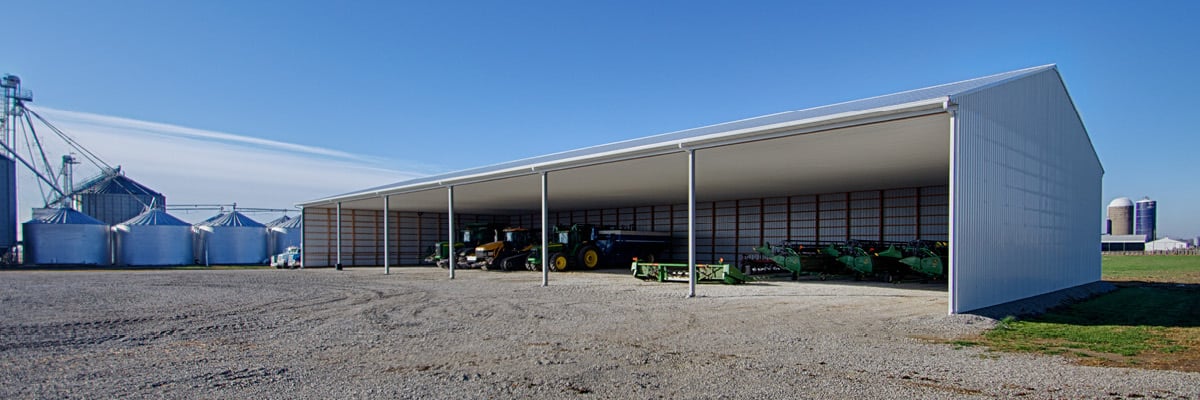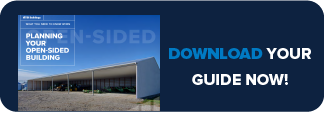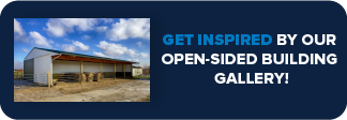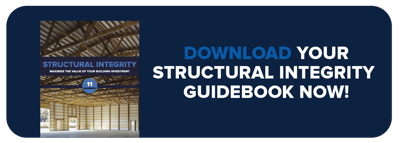Farm Buildings | Commercial Buildings | Cost | Open-Sided Buildings
3 Factors that Determine the Cost of an Open-Sided Building
Angie joined FBi Buildings in 2012 and is now the Director of Marketing. She's an avid reader and enjoys outdoor leisure and cheering on her two daughters at their sporting events.
Are you a hardworking farmer interested in extra storage space for large implements?
Are you a commercial business owner looking to protect your products or services from the elements?
Maybe you’re tired of leaving your equipment outdoors and would like to keep them protected under roof but easy enough to be still accessible when needed.Whatever the reason, it’s time for you to consider an open-sided building.
How Much Does an Open-Sided Building Cost?
The cost difference between an open-sided building and a fully enclosed building is much dependent on the bay spacing on the open sidewall. The “break-even” point, where the pricing is very similar, is 20’ wide headers at the open sidewall.
If the headers are wider than 20’, then an enclosed building is generally less expensive. If the bay spacing on the open sidewall is less than 20’, then the open-sided building is typically more cost-effective.
If you’re leaning towards an open-sided building, your price per square foot would be around $11 - $15, depending on the three factors mentioned above. This is a price range based on current market conditions and could change significantly going forward, based on the volatility of the commodity markets.
In this article, we’ll discuss the three benefits of an open-sided building and the three factors that play a role in how much an open-sided building costs.
3 Reasons Why You Should Consider an Open-Sided Building
1) Open-Sided Buildings Provide Convenient and Flexible Entry
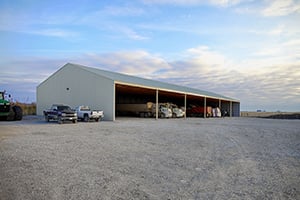 One of the most common uses for an open-sided or open-ended building is for machinery storage.
One of the most common uses for an open-sided or open-ended building is for machinery storage.
They’re also built for other purposes, such as:
- Transportation depots (e.g., buses and semis)
- Storage facilities (e.g., lumber and steel)
- Horse barns (e.g., run-in sheds for protection or hay storage)
Many consumers like to combine aspects of open-sided and post frame construction. They park in-season equipment underneath the lean-to for easy access. Meanwhile, out-of-season equipment is stored in the enclosed structure.
We understand that farmers and business owners are busy individuals. Therefore, site flow is crucial to the efficiency of their operation. For many, it’s a matter of mobility and time management.
Think about how you move around your property.
Are there any potential obstacles that could impact your site flow?
- Existing structures?
- Landscaping?
- Driveways?
You’ll need to consider these barriers before selecting a location for your open-sided pole building.
2) Open-sided Buildings Have Lower Maintenance Costs
Next, a three-sided building has fewer building features. Walk-in doors and windows are the most obvious features missing from the building design.
However, a building with three walls must yield the same structural loads as one with four.
Initially, an open-ended building isn't necessarily less expensive than a fully-enclosed pole barn. Addressing structural integrity concerns may increase costs because extra support is required. We’ll cover that later on.
3) Open-Sided Buildings Allow for Future Modifications
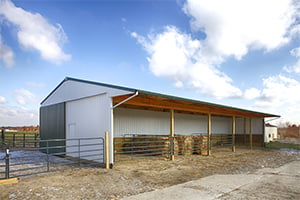 Lastly, you can always add features to your open-ended building at a later date.
Lastly, you can always add features to your open-ended building at a later date.
For example, most open-sided buildings have gravel floors. This filling type is a durable surface with the ability to withstand the weight of heavy machinery. It also provides significant drainage.
Other benefits of an open-sided structure include:
- Low risk of door damage (you don’t need overhead doors and sliding doors can be placed on the end walls, if necessary)
- Less waste of interior space
- Superior non-mechanical ventilation
3 Factors that Determine the Cost of an Open-Sided Building
1) Building Width & Height
It’s vital to carefully consider exactly how you intend to utilize your completed structure because it will influence the way it’s constructed.
If you remember our previous blog, 6 Ways to Build a Pole Barn on a Budget, we discussed how building width and height play a factor in the building’s overall cost.
As a refresh, remember these three tips when planning for your building.
- Keep your building’s width at 6’ increments and the length of your building at 8’ increments.
- If you’re looking to add height, 14’ - 16’ tall buildings will cost less than buildings that are over 16’ tall. This is partly because buildings over 16’ tall will use bigger columns to ensure proper structural integrity.
It’s also important to mention that it may be necessary to put a “face plate” in front of the column. This helps provide additional rigidity because you don’t have the sidewall metal to help with that.
With open-sided buildings, you have to rely on columns to make up the difference. - Any buildings over 80’ wide will use two-ply trusses instead of single-ply. The upgraded truss will also need to use four-ply columns instead of our standard three-ply.
2) Bay Spacing
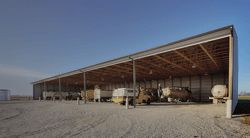 Depending on the size and shape of the machinery you intend to store, both now and in the future, different bay spacing and clearances may be required. If you want to build individual bays for each piece of machinery, this will change the layout and how columns are arranged.
Depending on the size and shape of the machinery you intend to store, both now and in the future, different bay spacing and clearances may be required. If you want to build individual bays for each piece of machinery, this will change the layout and how columns are arranged.
The bay spacing will also determine how much weight the header can carry.
You may want to add concrete bollards at each column to prevent damage from a tractor collision. If a column is hit, it may cause racking, sagging, or even a building collapse. Different and customized solutions may be required to meet your unique needs.
Racking is an effect of lateral forces exerted on a structure. If the building’s diaphragm is weakened, the building won’t be capable of resisting strong winds or other pressure forces, which may cause the entire structure to lean.
3) Wind Uplift
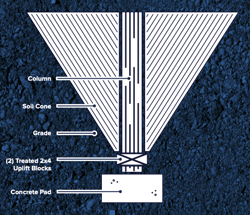 A building must be capable of withstanding the force of extreme winds. This means that adequately engineered footings, columns, trusses, and purlins must be used in construction. This also means that the building’s design must take into consideration the location of it’s being built.
A building must be capable of withstanding the force of extreme winds. This means that adequately engineered footings, columns, trusses, and purlins must be used in construction. This also means that the building’s design must take into consideration the location of it’s being built.
If there’s a gap or weakness in the buildings’ load path, the force will be transferred through building components that aren’t designed to bear those loads, which can cause the structure to fail or “uplift” due to forces from the wind.
A measurement called exposure rating is used to define the actual force of wind a building will have to endure, based on its geography and surroundings.
Wind speeds are calculated using wind speed maps based on historical weather data. The formula also considers building use, surrounding terrain, building height and dimensions, and the size and location of openings in the building.
In simpler terms, since this is a three-sided structure, the wind will find its way inside, build up pressure, and need somewhere to go. To help prevent this, you must take into consideration the size of your soil cone.
A soil cone is the earth directly above each column. Columns are built with lateral “ears” at the base, anchoring the column, and ultimately your building. We embed these a minimum of 4’ deep - sometimes deeper when necessary - to increase soil cone size and strength.
The easiest way to avoid catastrophic effects like uplift and building collapse? Build a fully engineered structure.
What’s the Cost Difference? Open-Sided vs Fully Enclosed
Often, there is a misconception that open-sided buildings cost less than fully enclosed structures. We could see why people would think that since you’re essentially saving on labor costs and using less material.
With that being said, the cost difference is much dependent on the bay spacing on the open sidewall. The “break-even” point, where the pricing is very similar, is 20’ wide headers at the open sidewall.
If the headers are wider than 20’, then an enclosed building is generally less expensive. If the bay spacing on the open sidewall is less than 20’, then the open-sided building is typically more cost-effective.
If you’re leaning towards an open-sided building, your price per square foot would be around $11 - $15, depending on the three factors mentioned above. This is a price range based on current market conditions and could change significantly going forward, based on the volatility of the commodity markets.
Is an Open-Sided Building Right for You?
Whether you’re a hardworking farmer or savvy commercial business owner, you can benefit from a versatile and efficient open-sided building.
In summary, these post frame structures:
- Can be constructed in a timely fashion
- Allow for easy access and entry
- Are relatively inexpensive in the long run
- Can be modified or expanded upon over time
For more information, you can download our free “Open-Sided Building Guide.” This e-book will further explain:
- Why an open-ended building can be a viable option for your operation
- How to plan an effective layout that maximizes site and workflow
- How to avoid structural failures caused by heavy snow and high winds
Are you ready for a quote? Submit your building design to us, and a member of our sales team will give you a call to begin the estimating process.
Have more questions about open-sided buildings not covered in this article? Please contact FBi Buildings at 1.800.552.2981 or click here to email us. If you’re ready to get a price, click here to request a quote, and a member of our sales team will call you.
